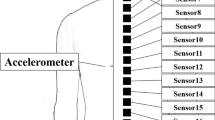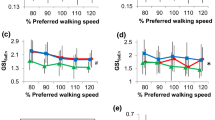Abstract
The purpose of this study was to investigate the relationship between oscillatory dynamics of the head and trunk in each plane of motion during walking. Head and trunk accelerations of ten healthy subjects (age: 23±4 years) were measured in the vertical (VT), anterior–posterior (AP) and mediolateral (ML) directions using a pair of tri-axial accelerometers. All subjects performed five walking trials along a level 20 m walkway at their preferred gait velocity (1.30±0.15 m s−1). Acceleration data were analysed using power spectral, harmonic and regularity measures. Results indicated that: (1) oscillations of the head were smoother, with a greater proportion of power at lower frequencies than oscillations of the trunk, (2) differences in power spectral properties between the head and trunk were most pronounced in the ML direction, (3) coupling between VT–AP, VT–ML, and AP–ML accelerations were greater for the head than trunk, and (4) for both segments, the weakest coupling was observed for AP–ML acceleration relations. Overall, the results of this study suggest that accelerations of the head are significantly attenuated, and more tightly controlled, compared to accelerations of the lower trunk. This attenuation process was particularly evident for the ML direction, whereby head accelerations showed the greatest differences compared to ML accelerations at the trunk.





Similar content being viewed by others
References
Auvinet B, Berrut G, Touzard C, Moutel L, Collet N, Chaleil D, Barrey E (2002). Reference data for normal subjects obtained with an accelerometric device. Gait Posture 16:124–134
Cappozzo A (1981). Analysis of the linear displacement of the head and trunk during walking at different speeds. J Biomech 14:411–425
Cromwell RL, Aadland-Monahan TK, Nelson AT, Stern-Sylvestre SM, Seder B (2001). Sagittal plane analysis of head, neck, and trunk kinematics and electromyographic activity during locomotion. J Orthop Sports Phys Ther 31:255–262
Freund H-J, Hefter H (1993). The role of basal ganglia in rhythmic movement. Adv Neurol 60:88–92
Gusenoff JA, Harman SM, Veldhuis JD, Jayme JJ, St Clair C, Munzer T, Christmas C, O’Connor KG, Stevens TE, Bellantoni MF, Pabst K, Blackman MR (2001). Cortisol and GH secretory dynamics, and their interrelationships, in healthy aged women and men. Am J Physiol 280:E616–E625
Hirasaki E, Moore ST, Raphan T, Cohen B (1999). Effects of walking velocity on vertical head and body movements during locomotion. Exp Brain Res 127:117–130
Holt KG, Ratcliffe RJ, Jeng S-F (1999). Head stability in walking in children with cerebral palsy and in children and adults without neurological impairment. Phys Ther 79:1153–1162
Imai T, Moore ST, Raphan T, Cohen B (2000). Interaction of the body, head, and eyes during walking and turning. Exp Brain Res 136:1–18
Kavanagh JJ, Barrett RS, Morrison S (2004). Upper body accelerations during walking in healthy young and elderly men. Gait Posture 20:291–298
Keshner EA, Peterson BW (1995). Mechanisms controlling human head stabilization. I. Head-neck dynamics during random rotations in the horizontal plane. J Neurophysiol 73:2293–2301
Keshner EA, Cromwell R, Peterson BW (1995). Mechanisms controlling human head stabilization. II. Head-neck characteristics during random rotations in the vertical plane. J Neurophysiol 73:2302–2312
Menz HB, Lord S, Fitzpatrick RC (2003a). Acceleration patterns of the head and pelvis when walking are associated with risk of falling in community-dwelling older people. J Gerontol A Biol Sci Med Sci 58:M446–M452
Menz HB, Lord SR, Fitzpatrick RC (2003b). Acceleration patterns of the head and pelvis when walking on level and irregular surfaces. Gait Posture 18:35–46
Menz HB, Lord SR, Fitzpatrick RC (2003c). Age-related differences in walking stability. Age Ageing 32:137–142
Moe-Nilssen R (1998). A new method for evaluating motor control in gait under real-life environmental conditions. Part 2: gait analysis. Clin Biomech 13:328–335
Moore ST, Hirasaki E, Cohen B, Raphan T (1999). Effect of viewing distance on the generation of vertical eye movements during locomotion. Exp Brain Res 129:347–361
Morrison S, Newell KM (1999). Bilateral organization of physiological tremor in the upper limb. Eur J Appl Physiol 80:564–574
Newell KM (1985) Coordination, control and skill, in differing perspectives in motor learning, memory and control. Elsevier, Amsterdam
Newell K (1986) Constraints on the development of coordination. In: Wade M, Whiting H (eds) Motor development in children: aspects of coordination and control. Martinus Nijhoff, Dordrecht, pp 341–360
Patla AE, Adkin AL, Ballard T (1999) Online steering: coordination and control of body center of mass, head and body reorientation. Exp Brain Res 129:629–634
Pincus SM (1991) Approximate entropy as a measure of system complexity. Proc Natl Acad Sci USA 88:2297–2301
Pincus SM (2000) Irregularity and asynchrony in biologic network signals, Methods in Enzymology, vol 321. Academic, New York, pp 149–182
Pincus SM (2001) Assessing serial irregularity and its implications for health. Ann N Y Acad Sci 954:245–267
Pincus SM, Singer BH (1996) Randomness and degrees of irregularity. Proc Natl Acad Sci USA 93:2083–2088
Pozzo T, Berthoz A, Lefort L (1990) Head stabilization during various locomotor tasks in humans. I. Normal subjects. Exp Brain Res 82:97–106
Prince F, Winter DA, Stergiou P, Walt SE (1994) Anticipatory control of upper body balance during human locomotion. Gait Posture 2:19–25
Ratcliffe RJ, Holt KG (1997) Low frequency shock absorbtion in human walking. Gait Posture 5:93–100
Smidt GL, Arora JS, Johnston RC (1971) Accelerographic analysis of several types of walking. Am J Phys Med 50:285–300
Thorstensson A, Nilsson J, Carlson H, Zomlefer MR (1984) Trunk movements in human locomotion. Acta Physiol Scand 121:9–22
Vaillancourt DE, Newell KM (2000) The dynamics of resting and postural tremor in Parkinson’s disease. Clin Neurophysiol 111:2046–2056
Veldhuis JD, Johnson ML, Veldhuis OL, Straume M, Pincus SM (2001) Impact of pulsatility on the ensemble orderliness (approximate entropy) of neurohormone secretion. Am J Physiol 281:R1975–R1985
Winter DA (1991) The biomechanics and motor control of human gait: normal, elderly and pathological. Waterloo biomechanics, Waterloo
Winter DA, Ruder GK, MacKinnon CD (1990). Control of balance of upper body during gait. Multiple muscle systems: biomechanics and movement organization. Springer, Berlin Heidelberg New York, pp 534–541
Winter DA, MacKinnon CD, Ruder GK, Wieman C (1993). An integrated EMG/biomechanical model of upper body balance and posture during human gait. Prog Brain Res 97:359–366
Winter DA, Prince F, Frank JS, Powell C, Zabjek KF (1996). Unified theory regarding A/P and M/L balance in quiet stance. J Neurophysiol 75:2334–2343
Yack HJ, Berger RC (1993). Dynamic stability in the elderly: identifying a possible measure. J Gerontol 48:M225–M230
Zedka M, Prochazka A (1997) Phasic activity in the human erector spinae during repetitive hand movements. J Physiol 504:727–734
Author information
Authors and Affiliations
Corresponding author
Rights and permissions
About this article
Cite this article
Kavanagh, J.J., Morrison, S. & Barrett, R.S. Coordination of head and trunk accelerations during walking. Eur J Appl Physiol 94, 468–475 (2005). https://doi.org/10.1007/s00421-005-1328-1
Accepted:
Published:
Issue Date:
DOI: https://doi.org/10.1007/s00421-005-1328-1




